1. Why has the concept of “crypto-stock” suddenly become popular?
1.1 The overall crypto market liquidity has deteriorated
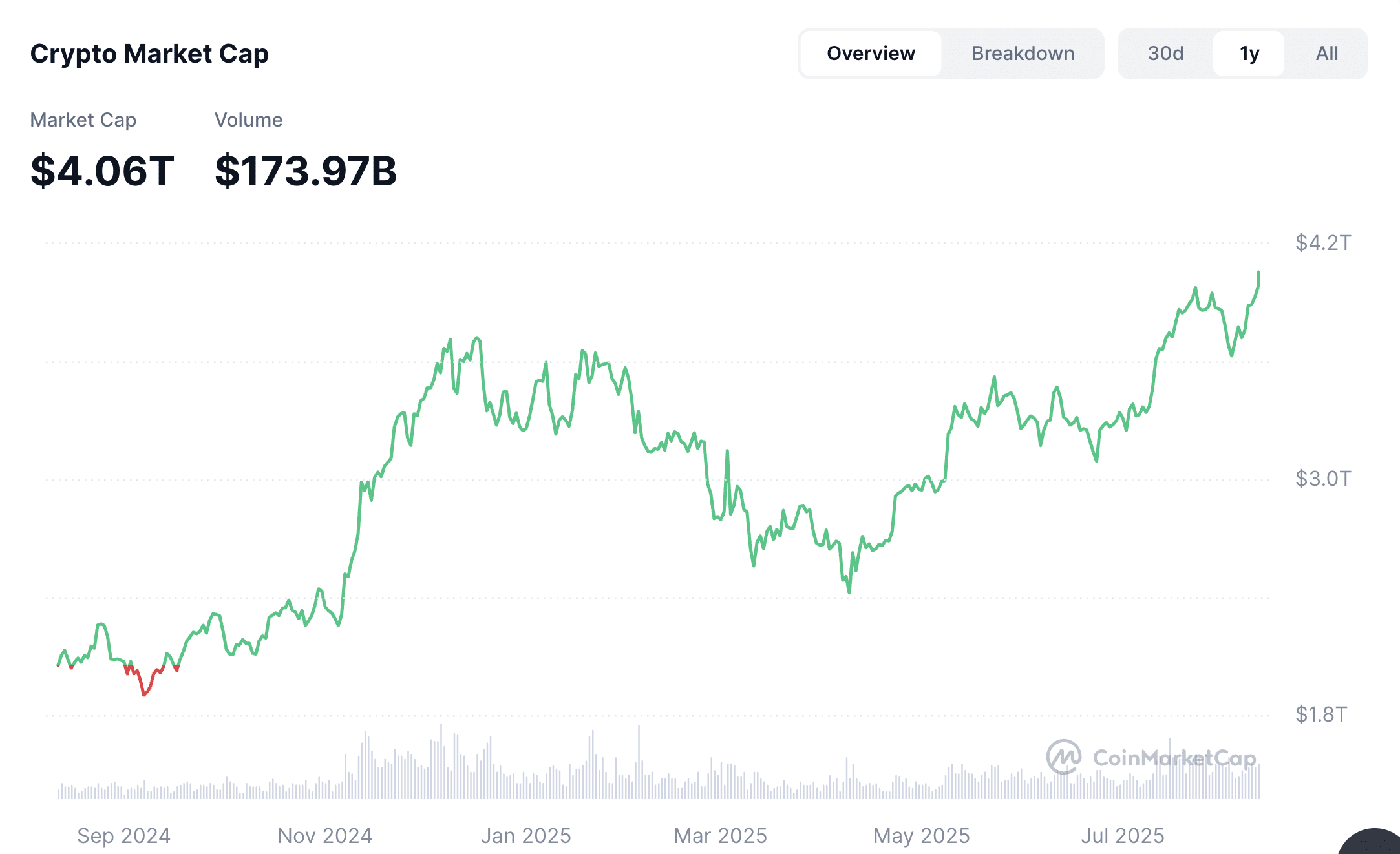
According to CoinMarketCap data, the cryptoasset market entered a significant upward cycle between November and December 2024. The total market capitalization increased from $2.26 trillion to $3.72 trillion, with average daily trading volume remaining at approximately $250 billion. Market activity increased significantly, demonstrating typical bull market characteristics.
However, since late January 2025, market sentiment has shifted due to the combined influence of multiple factors:
1. Macroeconomic factors: US tariff policy has created uncertainty and suppressed risk appetite;
2. Capital diversion: Celebrity tokens such as "Trump Coin," "Melania Meme," and "Libra, the Argentinian presidential-themed token," have attracted significant capital and trading attention in the short term.
3. Liquidity depletion and risk events: Subsequently, the prices of these tokens experienced drastic fluctuations and even crashes (Libra), causing some capital outflows and weakening market confidence in emerging projects.
Against this backdrop, on-chain activity and market sentiment gradually cooled, the crypto market entered a phase of adjustment, and the market capitalization and trading volume of the entire market both fell.
By May 2025, market sentiment reached a turning point. On the one hand, US inflation data fell short of expectations for two consecutive months, raising the market's expectations for a Federal Reserve rate cut this year. On the other hand, the negative impact of tariffs, which had sparked market concerns at the beginning of the year, gradually faded, and some trade and macroeconomic expectations recovered, leading to a rebound in risk appetite. Furthermore, the gradual opening of mainstream cryptoasset allocation access through various compliant channels (including ETFs, pension plans, and compliant custodial platforms) drove incremental capital inflows. During this period, "crypto-equity" assets (such as ETH and certain tokens with on-chain cash flows) became a key investment target, with a significant rebound in average daily trading volume.
By August 2025, the total crypto market capitalization exceeded $4.0 trillion, a record high. This current rally is characterized by both institutionalization and fundamentals. Unlike previous markets dominated by retail speculation, the overall capital structure is more robust than in the previous bull market, and the market's willingness to allocate to mainstream assets over the medium and long term has significantly increased.
As VC funding slows, crypto projects are forced to seek alternatives, highlighting the limitations of traditional financing methods.
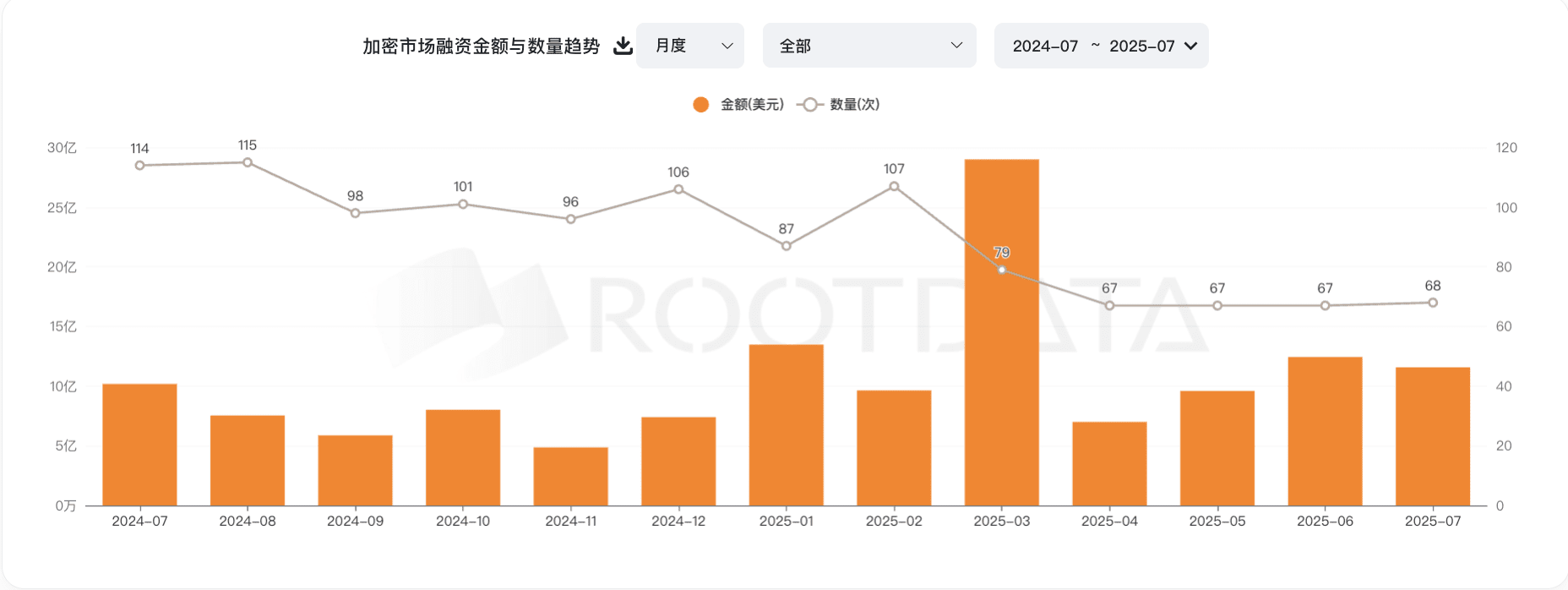
From July 2024 to July 2025, crypto market financing activity cooled significantly. According to RootData data, the number of project financings gradually declined from 114 in July 2024 to a low of 67 in April 2025, indicating that venture capital (VC) investment in new projects continued to decline.
Amidst slowing funding, some projects are opting to quickly secure funding by listing tokens first and then gradually releasing them, a strategy known as the "VC coin" model. A typical example is Binance Alpha, which attracted users through airdrops to quickly list on major exchanges. However, this model has exposed significant drawbacks in the current market environment. For example, despite backing from prominent institutions, projects like PRAI and XTER saw their tokens quickly fall below investor cost after listing. The fundamental reason for this is a high fully diluted valuation (FDV) and a low float ratio, which artificially inflated initial prices. As tokens were released during the lockup period, insufficient liquidity put downward pressure on prices.
This phenomenon not only undermines VC confidence in crypto projects but also negatively impacts retail investor sentiment. Institutional investors experience losses upon launch, while retail investors view "VC coins" as synonymous with "unlock and sell," decreasing their willingness to buy, creating a vicious cycle. The chart shows a sharp drop in funding rounds from 107 to 67 between February and April 2025, coinciding with a surge in VC coin price drops during that period.
In summary, the slowdown in VC funding and the collapse of "VC coins" are, in fact, different manifestations of the same structural market issue. On the one hand, the sluggish macroeconomic environment and market sentiment are prompting more cautious institutional investors; on the other hand, the token issuance model, characterized by high valuations, low circulation, and short-term cashing out, loses its appeal when the market cools. If future financing and token issuance mechanisms fail to innovate and break through, the price performance of "VC coins" will be difficult to improve, which will continue to hinder the recovery of market confidence.
Therefore, faced with a tightening financing environment and token price volatility, many VCs, seeking more stable and sustainable returns, have begun establishing companies through backdoor listings and other methods in regions with relatively lax market regulation, directly purchasing and holding cryptocurrencies as asset reserves. This model not only avoids the price volatility risks of traditional token issuance but also provides institutions with a compliant and long-term investment channel. This is the background and origin of the "crypto-equity company."
1.2 “Compliance”
The re-election of US President Donald Trump in 2024 marked a new era in the US regulatory environment for crypto assets. Upon taking office in early 2025, new Securities and Exchange Commission (SEC) Chairman Paul S. Atkins quickly implemented a series of crypto-friendly policies, clearly distinguishing most crypto assets from being securities and promoting the establishment of a dedicated regulatory framework for digital assets. This shift significantly boosted market confidence and accelerated regulatory compliance in the crypto industry.
Against this backdrop, in July 2025, Congress passed and President Trump signed the GENIUS Act (Guiding and Establishing National Innovation for U.S. Stablecoins Act), the first federal legislation in the United States targeting payment stablecoins. It established a clear regulatory system for the issuance and operation of stablecoins. The Act stipulates:
• Reserve assets must strictly maintain a 1:1 ratio, and stablecoin issuers must hold US dollars or highly liquid US Treasury bonds as reserves to ensure the redemption ability and stability of stablecoins.
• Transparency and audit requirements are strengthened, and issuers must disclose their financial status to regulators on a regular basis and undergo independent audits to ensure the authenticity and adequacy of their capital reserves.
• Anti-money laundering and sanctions compliance responsibilities are clear, and stablecoin issuers need to establish a complete anti-money laundering (AML) and customer identification (KYC) mechanism to prevent them from being used for illegal capital flows.
In addition, the U.S. Treasury Department has designated Bitcoin (BTC) as a national strategic reserve asset, allowing federal agencies to include Bitcoin in foreign exchange reserve portfolios. This not only highlights Bitcoin's status as digital gold, but also establishes authoritative endorsement for the entire digital asset market.
The clarity and easing of the regulatory environment has led to an increasing number of traditional financial institutions actively investing in the cryptoasset sector, willing to hold and trade digital currencies through compliant channels to avoid the high risks previously associated with regulatory uncertainty. This policy orientation has propelled cryptoassets from a marginal "gray area" into the mainstream financial asset class, becoming a crucial component of institutional investors' asset allocation.
1.3 Circle's listing and Coinbase's inclusion in the S&P have led more financial institutions to correctly view the investment attributes of cryptocurrencies.
Driven by this compliant environment, Circle successfully completed its initial public offering (IPO) in June 2025, raising over $1.1 billion. Its stock price surged 168% on its first day of trading, pushing its market capitalization to nearly $20 billion, making it one of the largest IPOs in the digital asset sector in recent years. This not only reflects the market's strong recognition of compliant stablecoin issuers, but also demonstrates investors' confidence in the long-term value of crypto assets as an emerging asset class. Circle's successful IPO broke through barriers to entry into traditional capital markets, marking a key milestone in the crypto industry's transition to the mainstream financial system and validating the feasibility of its compliant approach and the sustainability of its business model.
Meanwhile, in May 2025, Coinbase officially became the first crypto-native company to be included in the S&P 500 Index. This historic breakthrough not only lent broad legitimacy to the entire crypto industry but also significantly increased institutional investor recognition of crypto assets. With Coinbase's inclusion in mainstream indices, an increasing number of pension funds, insurance companies, and asset management institutions have begun incorporating crypto assets into their standard investment portfolios, driving greater diversification and stability in their fund structures.
This not only brings about significant economies of scale, but also prompts more crypto companies to strengthen compliance, improve governance and transparency to meet the strict requirements of institutional investors and promote the standardized development of the entire industry.
From the perspective of capital flows, the success of Circle and Coinbase has triggered a new influx of institutional funds. Data shows that in the second quarter of 2025, institutional investors' allocations to compliant crypto assets increased by over 40% year-on-year. In particular, there has been a significant increase in demand for holding digital assets through listed companies or regulated entities. This trend has effectively reduced traditional investors' concerns about price volatility and regulatory risks.
In addition, the compliant coin holding model helps institutions avoid the price volatility risks common in token issuance, achieves stable asset appreciation, and enhances the overall liquidity and resilience of the market.
Overall, the success of Circle and Coinbase has not only brought recognition from the capital market to the crypto industry, but more importantly, it has set a benchmark for compliant development in the industry, inspiring the market's broad imagination and firm confidence in the future of digital assets.
2. Financing channels for “coin-shares”
1. PIPE (Private Investment in Public Markets)
Operation Logic
○ Listed companies issue stocks or convertible bonds at a discount to specific institutional investors to quickly raise funds to buy large amounts of cryptocurrencies
○ With the rapid injection of PIPE funds, the company can quickly build a position and create a signal of "institutional entry", driving up the stock price.
○ Investment institutions enjoy discounted prices and priority, while retail investors follow suit at higher prices
Advantages
○ Fast financing and high flexibility
Institutional endorsements boost market confidence, while narrative marketing drives stock price increases.
○ Simple structure, suitable for quick momentum building
2. SPAC (Special Purpose Acquisition Company)
Operation Logic
○ Set up a shell company, raise funds and purchase cryptocurrency projects, bypassing the traditional IPO process and quickly listing
Raise funds through SPAC, PIPE, convertible bonds and other tools to purchase currency and build a "currency-based" balance sheet
○ Use the listing status to attract institutional buyers such as ETFs and hedge funds to enhance liquidity
Advantages
○ Fast listing speed (4-6 months) and diverse financing channels
○ The founding team retains more control and equity
○ Stocks are more easily accepted by mainstream trading platforms, enhancing legitimacy and investor confidence
3. ATM (Market Price Issuance)
Operation Logic
○ The company sells shares at irregular intervals and in stages based on market prices to raise cash for the purchase of cryptocurrencies.
○ There is no fixed price or time point, and additional issuance can be made at any time.
○ Provide flexible cash flow support for the company, enabling rapid increase in positions or replenishment of funds.
Advantages
○ High flexibility and low financing threshold.
○ No reliance on specific institutions, real-time response to market dynamics.
○ It is conducive to the continuous construction of a currency-based balance sheet.
4. Convertible Bond
Operation Logic
○ A company issues bonds with the right to convert them into shares.
○ Investors enjoy fixed interest on bonds, which can be converted into equity to make a profit when the stock price rises.
○ Companies can raise funds to buy tokens at a lower financing cost while delaying dilution.
○ When the stock price reaches the conversion price, the bonds are converted into stocks, releasing the selling pressure.
Advantages
○ Low financing costs and reduced immediate dilution.
○ Attract institutional investors because of debt security and equity potential.
○ Support enterprises to quickly expand their cryptocurrency holdings.
2.1 Driving Forces for the Surge in Crypto-Equity Companies
The rapid increase in the number of cryptocurrency-equity companies is mainly driven by the following factors:
• Regulatory stabilization and improved compliance framework: Crypto assets are gradually gaining policy recognition, laws are clear, institutions are willing to enter the market through compliant channels, and the coin-to-share company model has become the mainstream choice.
• Market financing channels are tightening: Traditional token issuance and VC financing are cooling down, and projects are seeking more stable and compliant ways to obtain funds. Backdoor listings and direct reserves have become alternatives.
• Changes in investor demand: Institutional and high-net-worth investors prefer to hold crypto assets through listed companies in compliance with regulations to avoid the regulatory and market volatility risks of direct currency holding.
• Demonstration effect of successful cases: The successful experiences of pioneers such as MicroStrategy, Circle, and Coinbase have inspired more companies to adopt the coin-share model, promoting the rapid development of the industry.
In summary, as a bridge connecting the traditional capital market and the crypto asset market, cryptocurrency-equity companies are becoming an important development trend in the industry with their advantages of legality and compliance, efficient financing, and diversified asset allocation.
3. Introduction to the “Coin-Stock” Case
3.1 The most successful case - MSTR
1. Background and Strategic Choice
The 2020 pandemic triggered a global liquidity crisis, and loose monetary policies around the world exacerbated inflation risks. Michael Saylor, believing Bitcoin to be the best alternative to fiat currency, led MicroStrategy (MSTR) to redirect its capital and financing capabilities toward large-scale Bitcoin purchases. Unlike traditional ETFs/ETPs that simply track price, MSTR directly holds the cryptocurrency, assuming the risk of price fluctuations while also benefiting from rising returns.
2. Source of Funds and Coin Purchase Process
MSTR's four major financing methods for purchasing tokens:
1. Own funds
For the first few investments, MicroStrategy used the idle funds on its books to make purchases.
In August 2020, MicroStrategy spent $250 million to purchase 21,400 Bitcoins.
○ In September, $175 million was invested to purchase 16,796 Bitcoins
○ In December, $50 million was invested to purchase 2,574 bitcoins
○ Later, from 22 to 24, I would occasionally use my own funds to buy coins
2. Convertible senior bonds (low or zero interest, betting on MSTR stock price growth)
Convertible senior bonds are financial instruments that allow investors to convert bonds into company stock under certain conditions.
These bonds feature low, or even zero, interest rates and a conversion price that is higher than the current stock price. Investors are attracted to these bonds primarily because of the downside protection they offer (i.e., the repayment of principal and interest upon maturity) and the potential for gains from rising stock prices.
The interest rates of several convertible bonds issued by MicroStrategy are mostly between 0% and 0.75%, indicating that investors are actually confident in the rise of MSTR's stock price and hope to earn more returns by converting bonds into stocks.

3. Senior secured bonds (secured, fixed income, prepaid)
In addition to convertible senior bonds, MicroStrategy also issued a $489 million senior secured bond with an interest rate of 6.125% and due in 2028.
Senior secured bonds are secured bonds with lower risk than convertible senior bonds, but they only pay fixed interest. MicroStrategy has chosen to repay the senior secured bonds early.
4. At-the-Market (ATM) (flexible, no debt repayment pressure, but dilutes equity)
MicroStrategy has entered into open market sales agreements with agent structures, including Jefferies, Cowen and Company LLC, and BTIG LLC, pursuant to which MicroStrategy may issue and sell Class A common stock through these agents from time to time.
Issuing shares at market price offers greater flexibility, allowing MicroStrategy to choose the timing of new share sales based on secondary market conditions. While issuing shares dilutes existing shareholders, the market's reaction to this move is complex due to factors such as its correlation with Bitcoin prices and the increase in the number of coins per share, resulting in higher overall MSTR stock price volatility.
By August 2025, MSTR has purchased a total of 628,946 bitcoins through the above four methods, with a total value of US$74.635 billion based on the current market price.
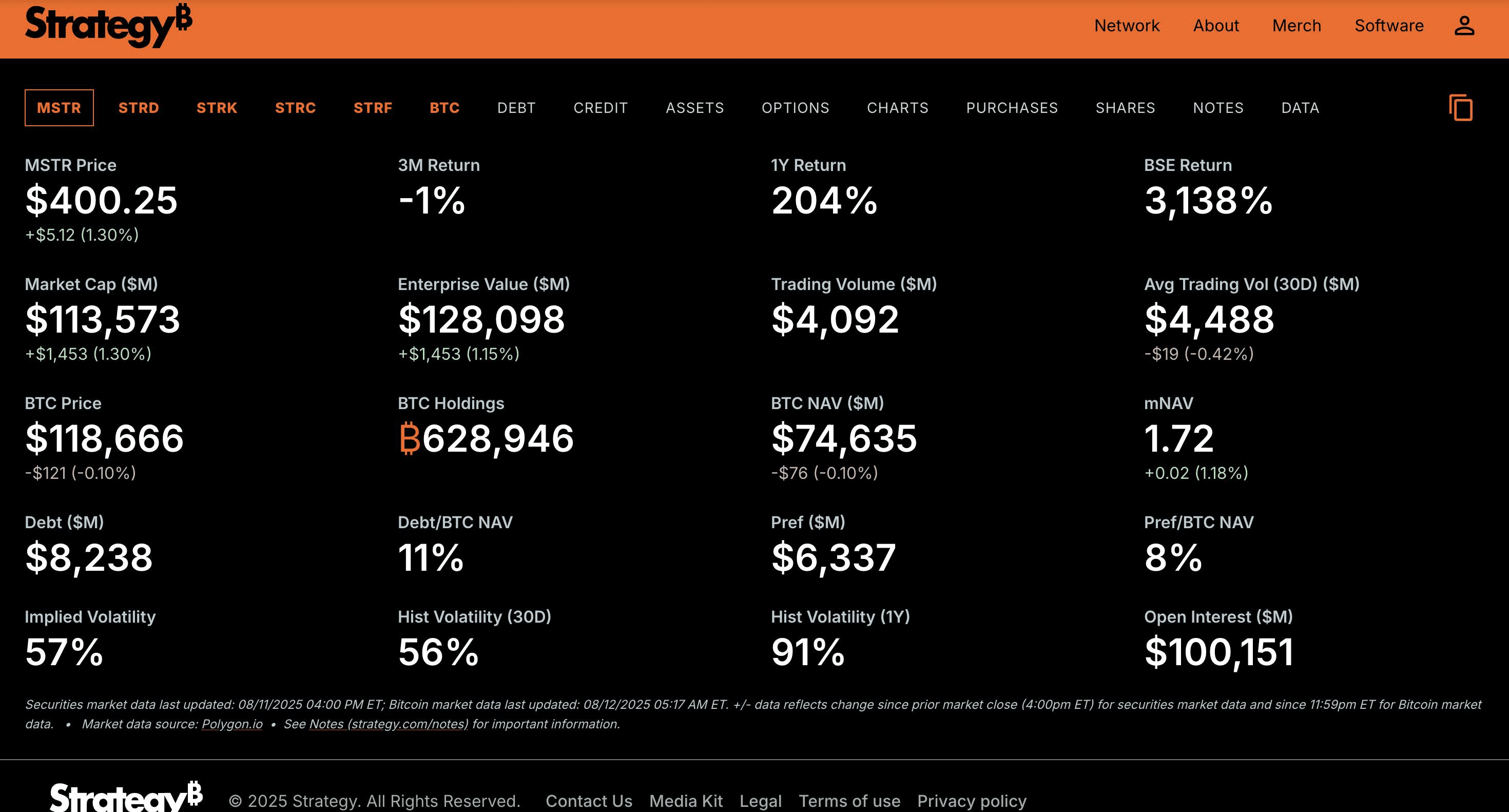
III. Stock Price Performance and Resilience (Core Strengths)
1. Amplify the rise
During the same period from 2024 to 2025, when BTC prices rose by approximately 166% ($45,000-$120,000), MSTR stock price rose by over 471% ($70-$400).
Reason: The market not only values it based on the BTC price, but also pays a premium for its financing capabilities and the expectation of additional purchases.
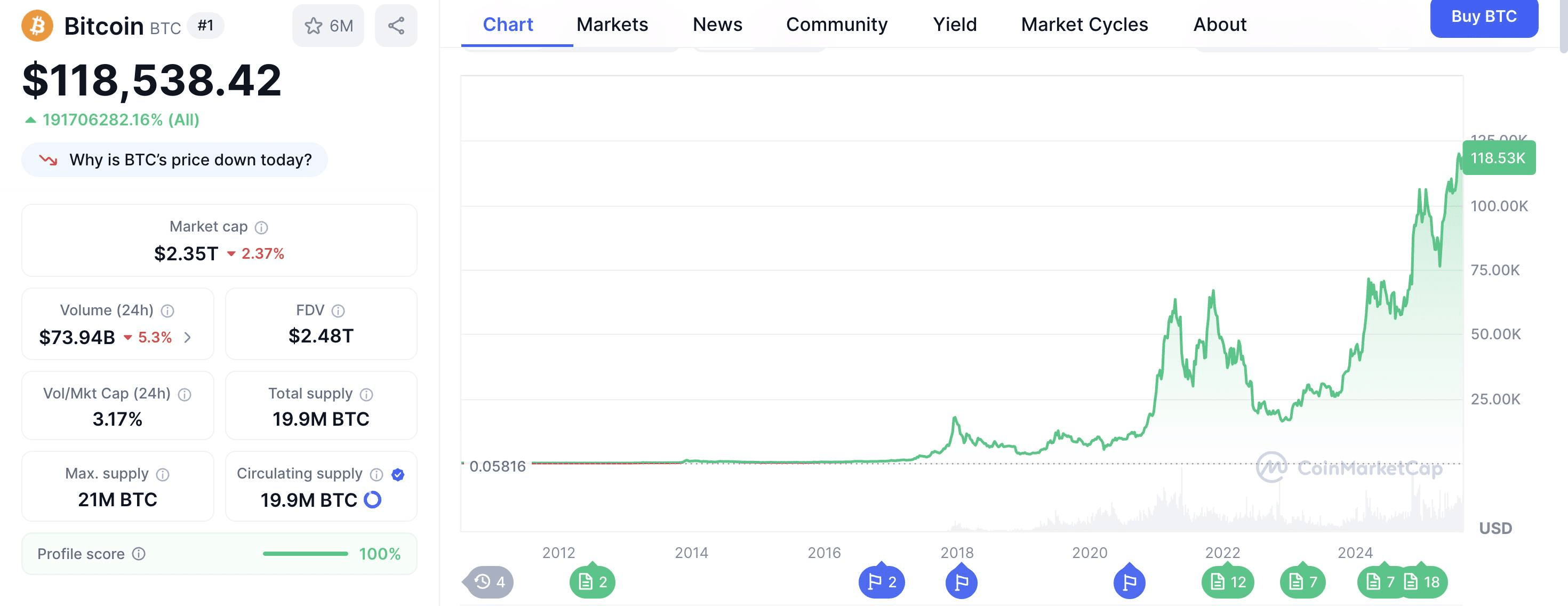
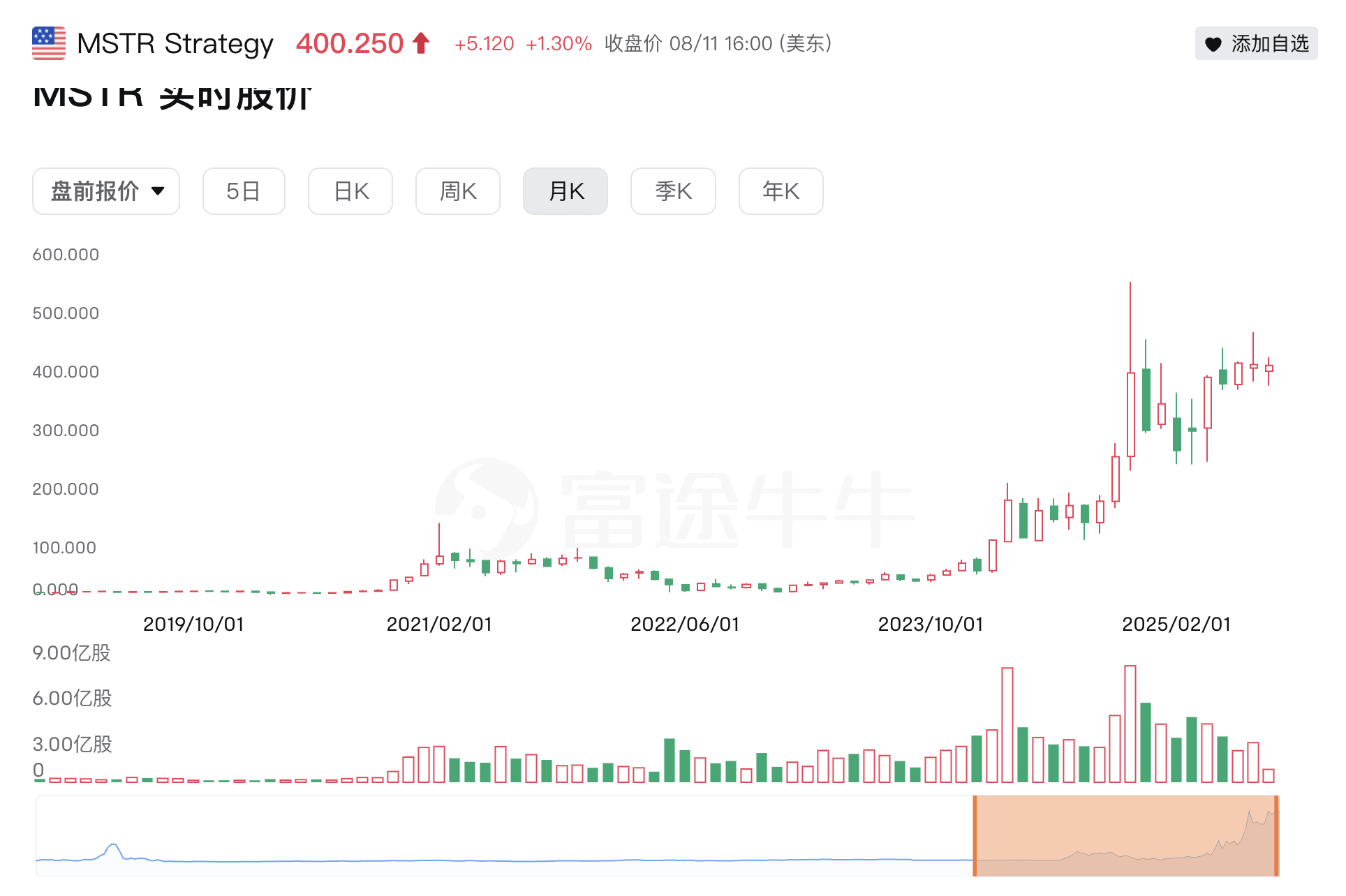
2. Strong resistance to price drops
During the 28% BTC correction (January 22, 2025, $106,000 to April 9, 2025, $76,000), MSTR's stock price fell by 15% ($353 to $300), mainly due to:
▪ Some shareholders hold shares for equity attributes and will not sell immediately due to short-term fluctuations in BTC.
▪ The market expects MSTR to continue buying at low prices, forming “dipping buying support”.
3. Historical advantages
○ As one of the earliest companies to purchase BTC on a large scale with funds from listed companies, MSTR has established a leading brand in terms of media exposure and investor awareness. Although ETFs/ETPs have low fees, they do not have the dual driving force of "operating expectations + asset appreciation".
3.2 The core buying forces driving this round of Ethereum’s rise: BMNR and SBET
The strongest performing asset in this cycle is undoubtedly Ethereum. As of August 11th, the price of Ethereum has soared from its April low of $1,472 to $4,271, a nearly 190% increase. Unlike previous cycles, where rallies were driven by retail investor sentiment, this round of gains is being driven by concentrated investments by financial institutions such as Wall Street.
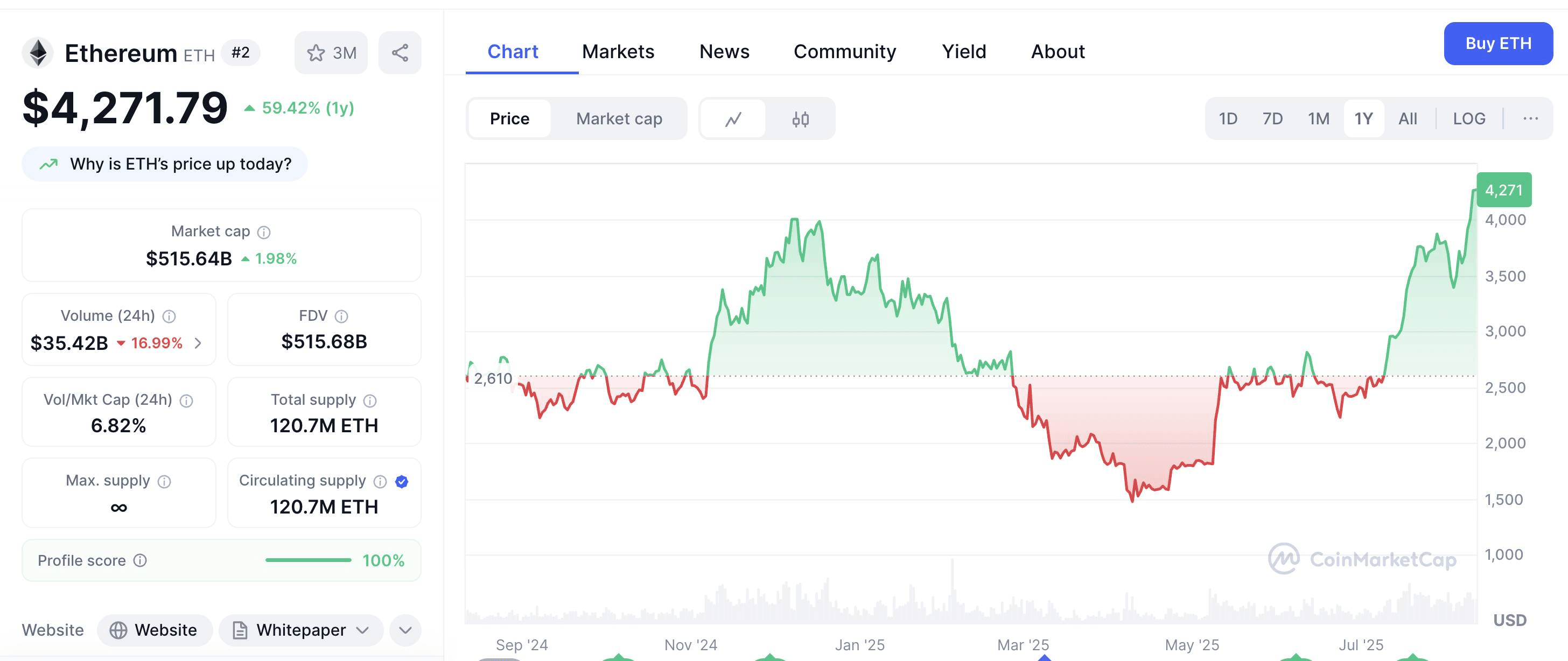
First, since May, the US Ethereum spot ETF has seen a continuous net inflow of funds, and the scale has continued to increase.
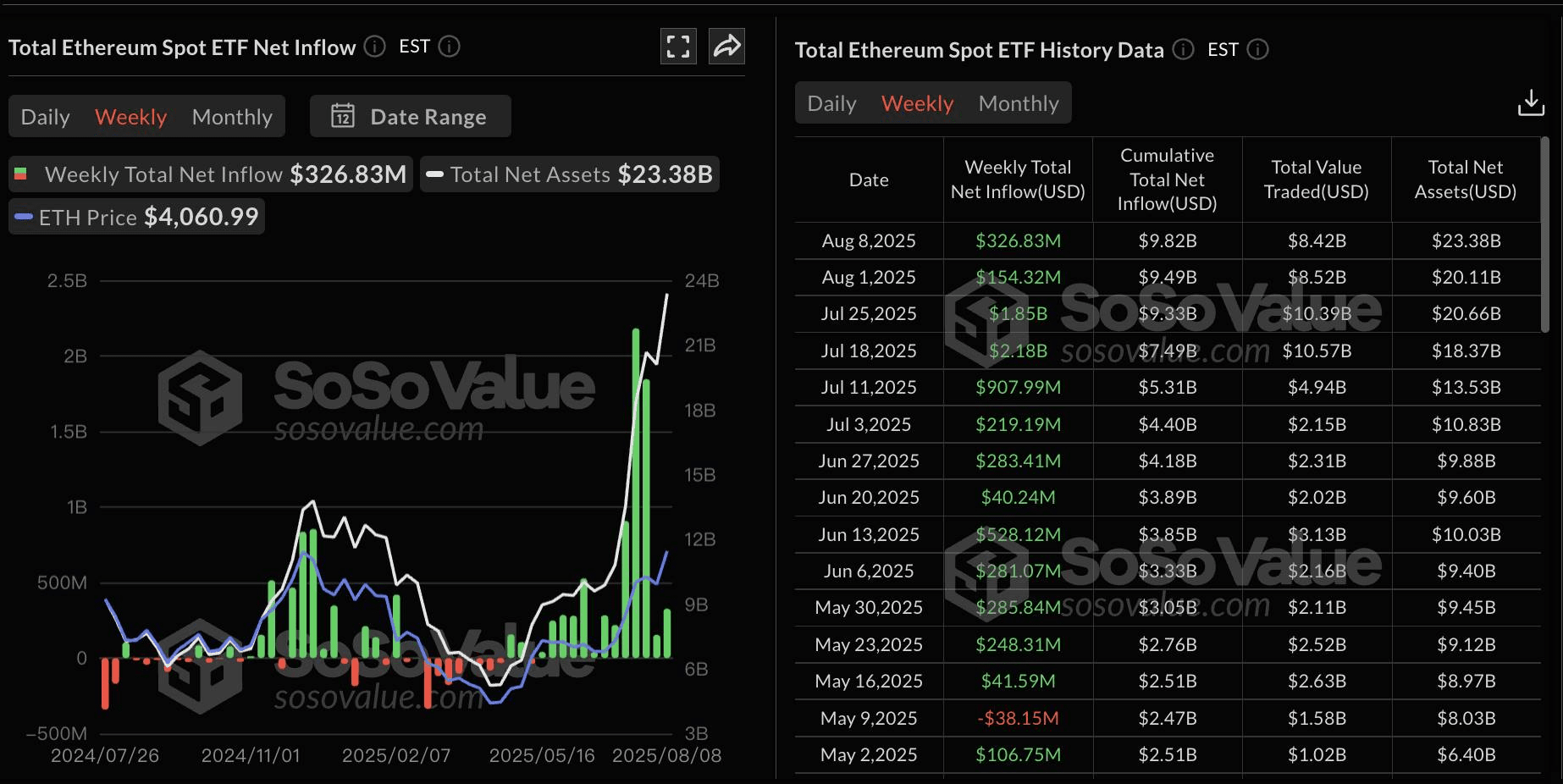
Secondly, a number of listed companies have begun incorporating Ethereum into strategic treasury reserves, purchasing ETH through equity financing and leveraging the appreciation of crypto assets to boost their market capitalization, creating a positive cycle of "share price, financing ability, and coin holdings." These "coin stocks" not only directly capture on-chain value but also enjoy a broader investor base and regulatory compliance advantages in the secondary market, becoming a core narrative in the new wave of crypto capital.
According to data from the Stragetic ETH Reserve website, over 10 publicly listed companies have publicly released strategic Ethereum reserves, with a combined purchase of over 1.928 million tokens. Based on the current price of Ethereum, this represents a total holding of over $8.2 billion, representing 1.6% of the circulating supply. Two companies in particular that warrant special attention are Bitmine (BMNR) and SharpLink (SBET).

BMNR:
1. Predecessor and name change
The company was originally named Sandy Springs Holdings, Inc. and changed its name and trading symbol to BMNR in March 2022 to reflect its focus on mining machine hosting and mining business using "immersion cooling" technology.
2. Main Business
– Hosting Services: Providing third-party mining companies with computer room hosting, power supply, rack, thermal management, and security services based on proprietary immersion cooling.
– Self-operated mining: using hosted mining machines to conduct self-operated Bitcoin mining;
– Equipment Sales and Software: Selling mining equipment and providing infrastructure management and customized firmware software.
3. Key Figure: Tom Lee
Known as the "Wall Street Prodigy," he has garnered widespread attention for his accurate market forecasts and insightful analysis of technology stocks, Bitcoin, and other assets. As the founder of the analytics firm Fundstrat, he is both a renowned analyst of traditional markets and a staunch supporter of digital assets like Bitcoin and Ethereum.
Lee was appointed Chairman of the Board of Directors of Bitmine, a mining company, and participated in the company's $250 million Ethereum treasury strategy, which attracted widespread market attention. In a recent interview, Tom Lee boldly predicted that Ethereum would climb to $10,000 during the current market cycle.
4. Financing history and methods

Click on the image to view the full spreadsheet
PIPE Private Equity Financing
June 30, 2025: BMNR successfully completed its PIPE private placement, issuing 55.6M shares of common stock (priced at approximately $4.50/share), raising approximately $250 million. The official disclosure stated that the funds will be used to launch the ETH treasury strategy.
ATM "At The Market" program launched
○ Early July 2025: The company announced the launch of an ATM stock issuance program, with an initial target of raising up to US$2 billion. Through Cantor Fitzgerald and ThinkEquity as sales agents, the company will gradually issue shares on the open market at market prices.
ATM limits increased to US$4.5 billion
July 24, 2025: BMNR submitted a supplementary document to the SEC, raising the ATM issuance limit from the original US$2 billion to US$4.5 billion.
Institutional investor participation: ARK Invest
July 22, 2025: BMNR announced that ARK Invest has participated in its existing ATM program and purchased company shares through block trades totaling $182 million. The announcement stated that 100% of ARK's net proceeds will be used to continue purchasing ETH. PR Newswire Stock Titan
ETH Reserve Progress
August 4, 2025: The company disclosed that as of that day, it held more than 833,137 ETH, worth approximately US$2.9 billion, becoming one of the world's largest publicly listed companies.
5. Investors

6. Current ETH holdings and stock price performance
According to the latest official disclosed data, BMNR currently holds a total of 1.15 million ETH, with a total value of US$5.29 billion at current prices. The company's current market value is US$6.444 billion.
BMNR's stock price has doubled since it fell to a relatively low point ($30) on August 1 and has now risen to $62 in just two weeks.
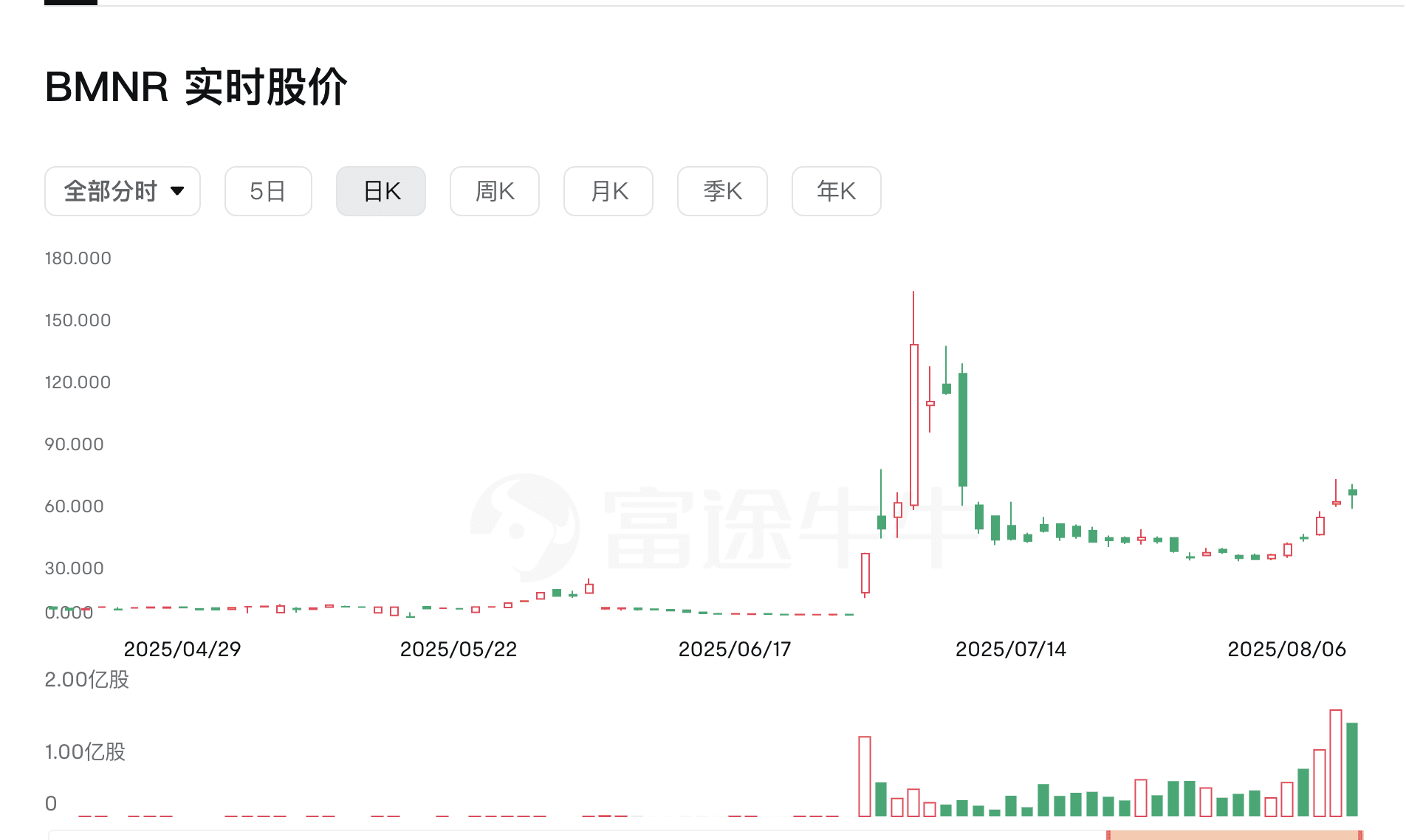
SBET:
1. Company Background and Reasons for Transformation
• SharpLink was formerly known as MER Telemanagement Solutions, established in 1995, which mainly engaged in traditional communications business. It turned to sports betting in 2019, but its revenue declined sharply in 2024 and it faced the risk of delisting.
• In May 2025, it was announced that Ethereum (ETH) would be used as the main treasury reserve asset through US$425 million PIPE financing to complete the transformation.
2. Timeline and Actions of the ETH Treasury Strategy
• On May 20th, SharpLink conducted a round of additional stock offering, raising $4.5 million at $2.94 per share. Officially, the funds will be used to “restore compliance with Nasdaq’s minimum shareholder equity requirements.” This round of funding was solely invested by ConsenSys, demonstrating the latter’s long-term investment in the Ethereum Reserve Company.
• On May 27, SharpLink Gaming announced its Ethereum treasury reserve strategy, aiming to raise $425 million to increase its holdings of Ethereum.
• SBET subsequently conducted multiple ATMs (public market issuances) to raise approximately $1 billion in cash for the purchase of ETH.
• On July 24, SharpLink held a shareholders meeting to issue additional shares to raise an additional $5 billion for ETH purchases
3. Key Figure: Joseph Lubin
Lubin is a co-founder of Ethereum, a leading figure in the blockchain industry, and the founder and CEO of ConsenSys, a blockchain development company. A graduate of Princeton University with a degree in Electrical Engineering and Computer Science, he has worked at institutions such as Goldman Sachs, bringing with him a deep background in technology and finance. He has long been committed to promoting decentralized applications and blockchain infrastructure, and is considered one of the key founders of the Ethereum ecosystem.
Currently serving as CEO of SharpLink Gaming, he led SBET to raise funds through additional stock issuance and other means to purchase and pledge ETH, and proposed the vision of tokenizing the company's stocks "on-chain" in the future, aiming to enhance the integration of the capital market and the blockchain world.
4. Financing history and methods
SharpLink raised $425 million in its initial fundraising via a private placement (PIPE) and subsequently conducted multiple ATM (ATM) share sales to raise capital. According to Lubin's latest interview, the company may consider issuing convertible bonds in the future.
5. Investors
Consensys Software Inc. served as the lead investor in the PIPE financing. Other participating investors included several well-known crypto venture capital and infrastructure firms, including:
• ParaFi Capital
• Electric Capital
• Panther Capital
• Arrington Capital
• Galaxy Digital
• Okay
• White Star Capital
• GSR
• Hivemind Capital
• Hypersphere
• Primitive Ventures
• Republic Digital
6. Current ETH holdings and stock price performance
According to the latest official disclosed data, SBET currently holds a total of 600,000 ETH, with a total value of US$2.76 billion at current prices, and the company's current market value is US$3.13 billion.
After experiencing a sell-off caused by "ATM dilution", SBET's stock price has risen from a low of $17 on August 1 to the current $24, an increase of more than 40%.
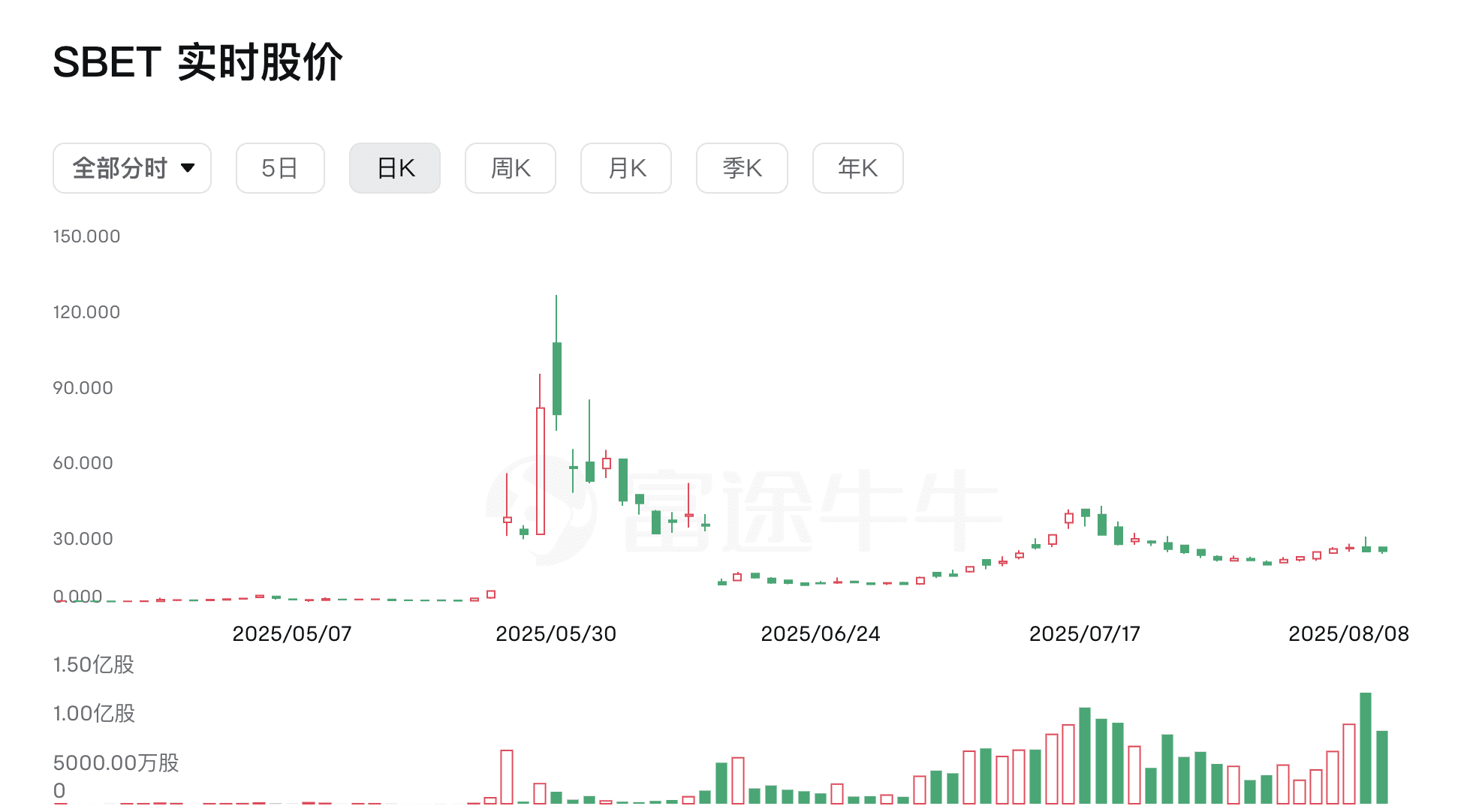
3.3 Reserves for Small-Cap Companies
ENA——StablecoinX
1. Listing Background and Transformation
StablecoinX was started by Nasdaq SPAC company TLGY Acquisition Corp. (TLGYF) raising $230 million through an IPO. The original plan was to merge with Verde Bioresins but failed.
○ In June 2024, it was taken over by the Carnegie Park Capital team and turned to the layout of the Ethena ecosystem.
2. Core Team
Jin-Goon Kim (Chairman of TLGYF), expert in finance and listed company transformation
Young Cho (StablecoinX CEO), experienced in crypto and SPAC mergers and acquisitions
Edward Chen (founder of CPC), senior SPAC investment strategy expert
3. PIPE Financing Structure
○ The total scale is approximately US$360 million, mainly used for strategic accumulation of ENA tokens.
○ $260 million in cash to purchase 1.23 billion ENA tokens (locked) at approximately $0.21 per ENA.
○ Approximately $100 million in discounted ENA tokens (including $60 million from the Ethena Foundation).
○ Lead investors: Dragonfly, Ribbit Capital, Blockchain.com, Pantera, Haun Ventures, Polychain, Galaxy Digital, etc.
4. Locking and unlocking arrangements
○ ENA tokens have a 48-month lock-up period.
○ 25% will be unlocked after 12 months of delivery, and the remaining 75% will be unlocked in equal monthly installments for 36 months.
5. Equity and Governance Structure
○ PIPE investors received Class A non-voting shares priced at $10 per share.
○ The Ethena Foundation holds Class B voting shares, which will be the majority after the transaction.
6. De-SPAC Transaction Structure
○ TLGYF merged with its subsidiary SPAC Merger Sub, which merged with the operating entity StablecoinX Assets Inc., ultimately forming the listed entity of StablecoinX Inc.
7. Valuation and Market Indicators
○ PIPE’s issue price is $10, and the number of shares will fluctuate based on the ENA token price.
○ It is expected to issue 101 million shares, and the total share capital after delivery will be approximately 104 million shares.
○ The fully diluted market capitalization is approximately US$1.43 billion, which roughly corresponds to the value of the 1.7 billion ENA tokens held (mNAV approximately 1×).
○ The valuation is discounted compared to MicroStrategy (1.5×) and BitMine Immersion (1.9×).
8. ENA price performance
Since July 22, the repurchase program initiated by the Ehena Foundation's subsidiaries through third-party market makers has repurchased 83 million ENA on the open market.
Since then, the price of ENA tokens has risen from a low of $0.25 at the end of June to the current $0.78, an increase of 212%.
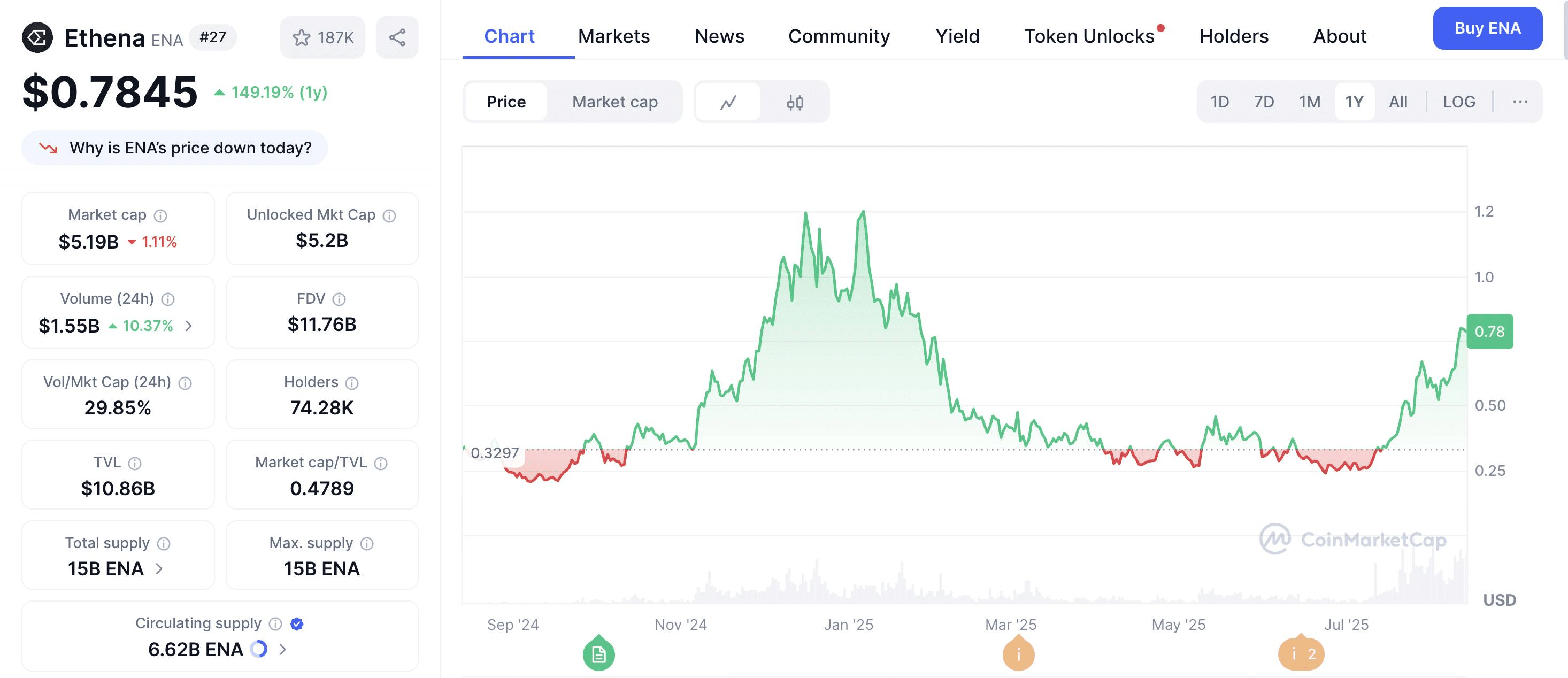
4. ATA Creativity Global(Nasdaq: AACG)
1. Transaction structure and capital scale
○ Date of Signing: August 2, 2025
Investor: Baby BTC Strategic Capital (Babylon Foundation is the main LP)
○ Investment method:
▪ New share subscription: US$30 million
▪ Warrants: $70 million
▪ Total investment size: US$100 million
Result: Baby Capital acquires control of ATA and appoints three directors to the board of directors
2. Strategic goals and differentiation
○ Different from MSTR (hoarding BTC) and SBET (focusing on ETH ecology) models
Core Competitiveness:
i. Activate the BTC ecosystem
• In-depth cooperation with Babylon project
• Introducing Bitcoin staking (BTC staking) to DeFi
ii. Large-scale acquisition of Baby tokens
• The circulating market value of Baby tokens is approximately $100 million
• ATA plans to use an equal amount of funds for acquisitions, equivalent to 100% reinvestment of the market value, which is expected to significantly increase the value of the token
3. Babylon Project Background
○ Bitcoin Layer 2 (L2) network, focusing on trustless BTC staking
○ Founders: David Tse (Stanford professor), Fisher Yu (former Dolby Laboratories senior engineer)
Funding: $96 million cumulatively (Paradigm, Polychain, OKX Ventures, Binance Labs, etc.)
○ Mainnet: Launched in August 2024
Total staked value: > $5 billion by July 2025
○Baby tokens are now listed on major exchanges such as Binance, OKX, Bybit, and KuCoin.
4. Future plans of listed companies
Treasury Strategy:
▪ Most of the funds are invested in Baby tokens
▪ A small portion of funds invested in BTC
Funding Sources:
PIPE (Private Equity Offering)
▪ ATM (market price issuance)
▪ Convertible bonds
○ Acquisition strategy: Continue to acquire Baby tokens & BTC in the market
○ Expected results:
▪ Drive asset value growth
▪ Promote market value increase
▪ Build a positive feedback loop of asset appreciation and market value improvement

